Kangning Zhang
Fints: Efficient Inference-Time Personalization for LLMs with Fine-Grained Instance-Tailored Steering
Oct 31, 2025Abstract:The rapid evolution of large language models (LLMs) has intensified the demand for effective personalization techniques that can adapt model behavior to individual user preferences. Despite the non-parametric methods utilizing the in-context learning ability of LLMs, recent parametric adaptation methods, including personalized parameter-efficient fine-tuning and reward modeling emerge. However, these methods face limitations in handling dynamic user patterns and high data sparsity scenarios, due to low adaptability and data efficiency. To address these challenges, we propose a fine-grained and instance-tailored steering framework that dynamically generates sample-level interference vectors from user data and injects them into the model's forward pass for personalized adaptation. Our approach introduces two key technical innovations: a fine-grained steering component that captures nuanced signals by hooking activations from attention and MLP layers, and an input-aware aggregation module that synthesizes these signals into contextually relevant enhancements. The method demonstrates high flexibility and data efficiency, excelling in fast-changing distribution and high data sparsity scenarios. In addition, the proposed method is orthogonal to existing methods and operates as a plug-in component compatible with different personalization techniques. Extensive experiments across diverse scenarios--including short-to-long text generation, and web function calling--validate the effectiveness and compatibility of our approach. Results show that our method significantly enhances personalization performance in fast-shifting environments while maintaining robustness across varying interaction modes and context lengths. Implementation is available at https://github.com/KounianhuaDu/Fints.
A Survey of Process Reward Models: From Outcome Signals to Process Supervisions for Large Language Models
Oct 09, 2025Abstract:Although Large Language Models (LLMs) exhibit advanced reasoning ability, conventional alignment remains largely dominated by outcome reward models (ORMs) that judge only final answers. Process Reward Models(PRMs) address this gap by evaluating and guiding reasoning at the step or trajectory level. This survey provides a systematic overview of PRMs through the full loop: how to generate process data, build PRMs, and use PRMs for test-time scaling and reinforcement learning. We summarize applications across math, code, text, multimodal reasoning, robotics, and agents, and review emerging benchmarks. Our goal is to clarify design spaces, reveal open challenges, and guide future research toward fine-grained, robust reasoning alignment.
An Automatic Graph Construction Framework based on Large Language Models for Recommendation
Dec 24, 2024Abstract:Graph neural networks (GNNs) have emerged as state-of-the-art methods to learn from graph-structured data for recommendation. However, most existing GNN-based recommendation methods focus on the optimization of model structures and learning strategies based on pre-defined graphs, neglecting the importance of the graph construction stage. Earlier works for graph construction usually rely on speciffic rules or crowdsourcing, which are either too simplistic or too labor-intensive. Recent works start to utilize large language models (LLMs) to automate the graph construction, in view of their abundant open-world knowledge and remarkable reasoning capabilities. Nevertheless, they generally suffer from two limitations: (1) invisibility of global view (e.g., overlooking contextual information) and (2) construction inefficiency. To this end, we introduce AutoGraph, an automatic graph construction framework based on LLMs for recommendation. Specifically, we first use LLMs to infer the user preference and item knowledge, which is encoded as semantic vectors. Next, we employ vector quantization to extract the latent factors from the semantic vectors. The latent factors are then incorporated as extra nodes to link the user/item nodes, resulting in a graph with in-depth global-view semantics. We further design metapath-based message aggregation to effectively aggregate the semantic and collaborative information. The framework is model-agnostic and compatible with different backbone models. Extensive experiments on three real-world datasets demonstrate the efficacy and efffciency of AutoGraph compared to existing baseline methods. We have deployed AutoGraph in Huawei advertising platform, and gain a 2.69% improvement on RPM and a 7.31% improvement on eCPM in the online A/B test. Currently AutoGraph has been used as the main trafffc model, serving hundreds of millions of people.
Learning ID-free Item Representation with Token Crossing for Multimodal Recommendation
Oct 25, 2024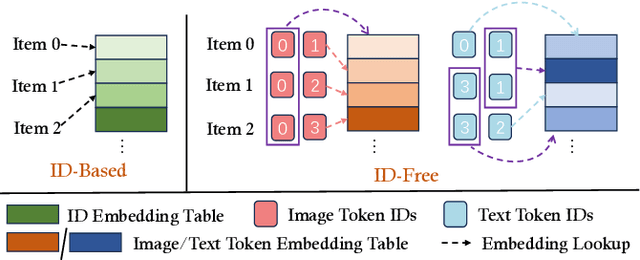

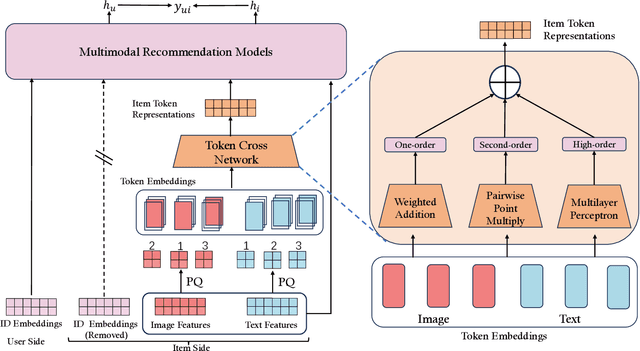
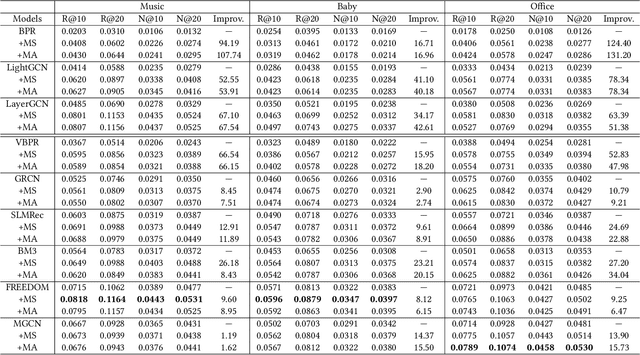
Abstract:Current multimodal recommendation models have extensively explored the effective utilization of multimodal information; however, their reliance on ID embeddings remains a performance bottleneck. Even with the assistance of multimodal information, optimizing ID embeddings remains challenging for ID-based Multimodal Recommender when interaction data is sparse. Furthermore, the unique nature of item-specific ID embeddings hinders the information exchange among related items and the spatial requirement of ID embeddings increases with the scale of item. Based on these limitations, we propose an ID-free MultimOdal TOken Representation scheme named MOTOR that represents each item using learnable multimodal tokens and connects them through shared tokens. Specifically, we first employ product quantization to discretize each item's multimodal features (e.g., images, text) into discrete token IDs. We then interpret the token embeddings corresponding to these token IDs as implicit item features, introducing a new Token Cross Network to capture the implicit interaction patterns among these tokens. The resulting representations can replace the original ID embeddings and transform the original ID-based multimodal recommender into ID-free system, without introducing any additional loss design. MOTOR reduces the overall space requirements of these models, facilitating information interaction among related items, while also significantly enhancing the model's recommendation capability. Extensive experiments on nine mainstream models demonstrate the significant performance improvement achieved by MOTOR, highlighting its effectiveness in enhancing multimodal recommendation systems.
DRepMRec: A Dual Representation Learning Framework for Multimodal Recommendation
Apr 17, 2024



Abstract:Multimodal Recommendation focuses mainly on how to effectively integrate behavior and multimodal information in the recommendation task. Previous works suffer from two major issues. Firstly, the training process tightly couples the behavior module and multimodal module by jointly optimizing them using the sharing model parameters, which leads to suboptimal performance since behavior signals and modality signals often provide opposite guidance for the parameters updates. Secondly, previous approaches fail to take into account the significant distribution differences between behavior and modality when they attempt to fuse behavior and modality information. This resulted in a misalignment between the representations of behavior and modality. To address these challenges, in this paper, we propose a novel Dual Representation learning framework for Multimodal Recommendation called DRepMRec, which introduce separate dual lines for coupling problem and Behavior-Modal Alignment (BMA) for misalignment problem. Specifically, DRepMRec leverages two independent lines of representation learning to calculate behavior and modal representations. After obtaining separate behavior and modal representations, we design a Behavior-Modal Alignment Module (BMA) to align and fuse the dual representations to solve the misalignment problem. Furthermore, we integrate the BMA into other recommendation models, resulting in consistent performance improvements. To ensure dual representations maintain their semantic independence during alignment, we introduce Similarity-Supervised Signal (SSS) for representation learning. We conduct extensive experiments on three public datasets and our method achieves state-of-the-art (SOTA) results. The source code will be available upon acceptance.
An Aligning and Training Framework for Multimodal Recommendations
Mar 20, 2024



Abstract:With the development of multimedia applications, multimodal recommendations are playing an essential role, as they can leverage rich contexts beyond user interactions. Existing methods mainly regard multimodal information as an auxiliary, using them to help learn ID features; however, there exist semantic gaps among multimodal content features and ID features, for which directly using multimodal information as an auxiliary would lead to misalignment in representations of users and items. In this paper, we first systematically investigate the misalignment issue in multimodal recommendations, and propose a solution named AlignRec. In AlignRec, the recommendation objective is decomposed into three alignments, namely alignment within contents, alignment between content and categorical ID, and alignment between users and items. Each alignment is characterized by a specific objective function and is integrated into our multimodal recommendation framework. To effectively train our AlignRec, we propose starting from pre-training the first alignment to obtain unified multimodal features and subsequently training the following two alignments together with these features as input. As it is essential to analyze whether each multimodal feature helps in training, we design three new classes of metrics to evaluate intermediate performance. Our extensive experiments on three real-world datasets consistently verify the superiority of AlignRec compared to nine baselines. We also find that the multimodal features generated by AlignRec are better than currently used ones, which are to be open-sourced.
3D Diffusion Policy
Mar 06, 2024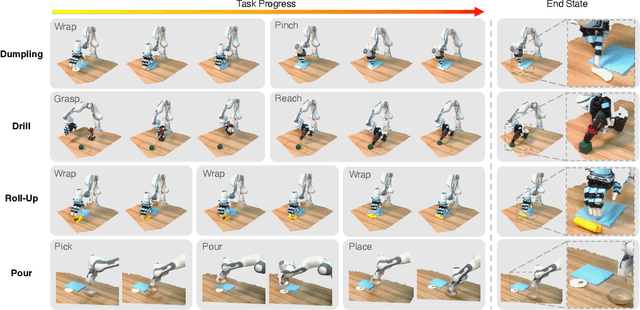

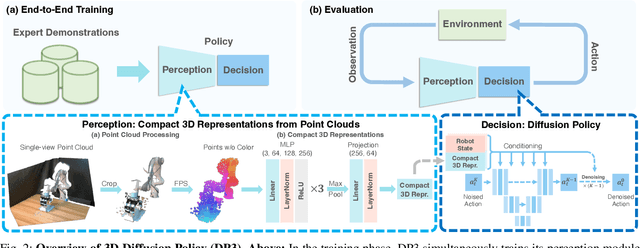

Abstract:Imitation learning provides an efficient way to teach robots dexterous skills; however, learning complex skills robustly and generalizablely usually consumes large amounts of human demonstrations. To tackle this challenging problem, we present 3D Diffusion Policy (DP3), a novel visual imitation learning approach that incorporates the power of 3D visual representations into diffusion policies, a class of conditional action generative models. The core design of DP3 is the utilization of a compact 3D visual representation, extracted from sparse point clouds with an efficient point encoder. In our experiments involving 72 simulation tasks, DP3 successfully handles most tasks with just 10 demonstrations and surpasses baselines with a 55.3% relative improvement. In 4 real robot tasks, DP3 demonstrates precise control with a high success rate of 85%, given only 40 demonstrations of each task, and shows excellent generalization abilities in diverse aspects, including space, viewpoint, appearance, and instance. Interestingly, in real robot experiments, DP3 rarely violates safety requirements, in contrast to baseline methods which frequently do, necessitating human intervention. Our extensive evaluation highlights the critical importance of 3D representations in real-world robot learning. Videos, code, and data are available on https://3d-diffusion-policy.github.io .
ClickPrompt: CTR Models are Strong Prompt Generators for Adapting Language Models to CTR Prediction
Oct 17, 2023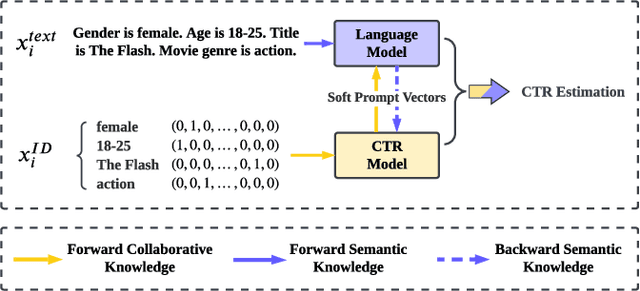

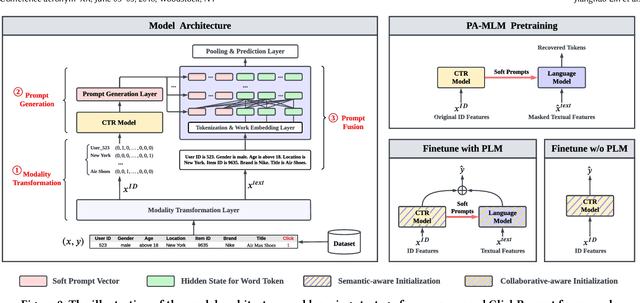
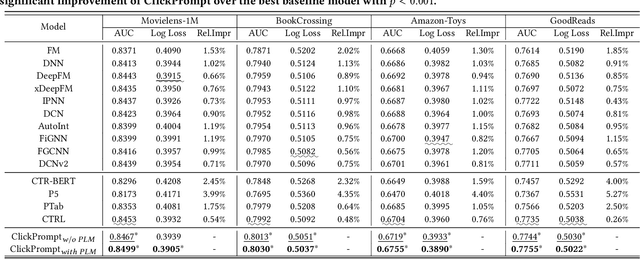
Abstract:Click-through rate (CTR) prediction has become increasingly indispensable for various Internet applications. Traditional CTR models convert the multi-field categorical data into ID features via one-hot encoding, and extract the collaborative signals among features. Such a paradigm suffers from the problem of semantic information loss. Another line of research explores the potential of pretrained language models (PLMs) for CTR prediction by converting input data into textual sentences through hard prompt templates. Although semantic signals are preserved, they generally fail to capture the collaborative information (e.g., feature interactions, pure ID features), not to mention the unacceptable inference overhead brought by the huge model size. In this paper, we aim to model both the semantic knowledge and collaborative knowledge for accurate CTR estimation, and meanwhile address the inference inefficiency issue. To benefit from both worlds and close their gaps, we propose a novel model-agnostic framework (i.e., ClickPrompt), where we incorporate CTR models to generate interaction-aware soft prompts for PLMs. We design a prompt-augmented masked language modeling (PA-MLM) pretraining task, where PLM has to recover the masked tokens based on the language context, as well as the soft prompts generated by CTR model. The collaborative and semantic knowledge from ID and textual features would be explicitly aligned and interacted via the prompt interface. Then, we can either tune the CTR model with PLM for superior performance, or solely tune the CTR model without PLM for inference efficiency. Experiments on four real-world datasets validate the effectiveness of ClickPrompt compared with existing baselines.
CodeApex: A Bilingual Programming Evaluation Benchmark for Large Language Models
Sep 10, 2023



Abstract:With the emergence of Large Language Models (LLMs), there has been a significant improvement in the programming capabilities of models, attracting growing attention from researchers. We propose CodeApex, a bilingual benchmark dataset focusing on the programming comprehension and code generation abilities of LLMs. CodeApex comprises three types of multiple-choice questions: conceptual understanding, commonsense reasoning, and multi-hop reasoning, designed to evaluate LLMs on programming comprehension tasks. Additionally, CodeApex utilizes algorithmic questions and corresponding test cases to assess the code quality generated by LLMs. We evaluate 14 state-of-the-art LLMs, including both general-purpose and specialized models. GPT exhibits the best programming capabilities, achieving approximate accuracies of 50% and 56% on the two tasks, respectively. There is still significant room for improvement in programming tasks. We hope that CodeApex can serve as a reference for evaluating the coding capabilities of LLMs, further promoting their development and growth. Datasets are released at https://github.com/APEXLAB/CodeApex.git. CodeApex submission website is https://apex.sjtu.edu.cn/codeapex/.
 Add to Chrome
Add to Chrome Add to Firefox
Add to Firefox Add to Edge
Add to Edge